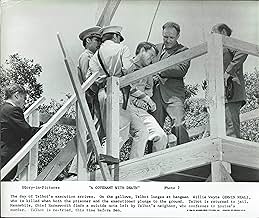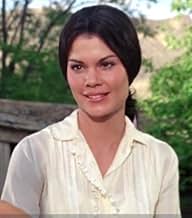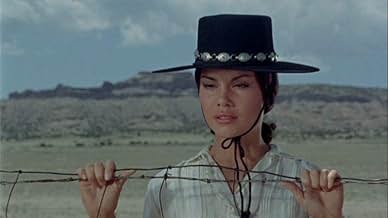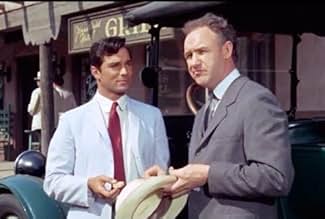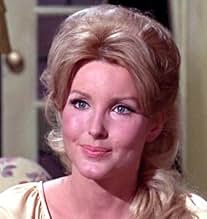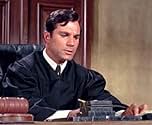Ajouter une intrigue dans votre langueA convicted murderer kills his hangman. Then it is discovered that he actually didn't commit the murder he was convicted for.A convicted murderer kills his hangman. Then it is discovered that he actually didn't commit the murder he was convicted for.A convicted murderer kills his hangman. Then it is discovered that he actually didn't commit the murder he was convicted for.
- Réalisation
- Scénario
- Casting principal
Emilio Fernández
- Ignacio
- (as Emilio Fernandez)
Walter Bacon
- Trial Spectator
- (non crédité)
Al Bain
- Trial Spectator
- (non crédité)
Avis à la une
... , being the highlighted film on a night of films on Turner Classic Movies starring Gene Hackman who is nary to be found, but I'm OK with that because it was very good. The central figure is a newly appointed Hispanic judge in New Mexico, just twelve years after the territory has become a state. George Maharis plays that young judge, Ben Lewis. He is generally accepted by the legal community, but they have some doubts, some voiced some not, somewhat because of his inexperience, and somewhat because he is of Mexican heritage.
The central legal case has to do with a local real estate salesman found crying next to his recently murdered wife. (Earl Holliman as Brian Talbot). He is arrested for the crime, and although the evidence is completely circumstantial and Talbot never waivers in his declaration of innocence, he is convicted. The only penalty the law allows is death, and thus the older judge, who has been presiding, sentences him to hang, which is the only sentence he can give him. Ben can't help thinking that Talbot's past behavior, the fact that the whole town knew he gave his wife an STD that caused her to have a hysterectomy, the fact that she punished Ben for this by being openly promiscuous for years, was the real reason for his conviction.
The older judge then goes off on a fishing jaunt, thinking the work is done. What he doesn't know is that things are about to really get tricky. When Talbot is hauled to the hangman's noose, and I mean as in kicking and screaming, he makes Daffy Duck look like a profile in courage. He is crying and struggling all of the way, and then in his attempt to avoid that noose on the scaffold he falls off, taking the hangman with him. The hangman hits his head on a rock and then dies. Talbot is alright. So now they have to wait until the next day for another hangman.
In the interim the real murderer writes out a confession and commits suicide. Now the town needs a judge again, to absolve Talbot of the original crime, and to deal with the fact that he did cause the death of the hangman in clear view of two dozen people, and what penalty or charge should be attached to that action. With the older judge out of town and unreachable, it falls to young judge Ben Lewis to handle a case that might make the supreme court scratch their collective heads. After he receives briefs from both the prosecuting and defense attorneys, he is off to study case law, read the attorneys' briefs, and even discuss the case with legal scholars. Oh, and then there is that pesky conscience of his too.
I think this was supposed to be a film about the death penalty, about its finality and its justice, as viewed from the eyes of a man who has made it to the office of judge but is still not given his dues because of lingering prejudice. And that prejudice does not stop with the white community. Katy Jurado as Ben's mother is ultra traditional, very unhappy with Ben's current blue eyed blonde girlfriend, and wants him to marry a Mexican girl. I think Ben rightly sums it up when he says she wants to continue to rule over the house even after his marriage and knows an Anglo girl won't take being bossed around.
I'd give this film an eight if not for so much of the injection of Ben's love life into the film. I know this was 1967 and that Hollywood was just so excited that they could finally show couples in bed together, but Ben's behavior with women ultimately made him look like a - well not Tom or Harry, the other guy. And his ultimate decision in his love life had me going "What the...?". It just went against everything he had been saying and doing up to that point.
This film supposedly got Gene Hackman noticed, at least the TCM host said that it did, but I don't know why because he has few lines and plays his part like the supporting role that it is.
The central legal case has to do with a local real estate salesman found crying next to his recently murdered wife. (Earl Holliman as Brian Talbot). He is arrested for the crime, and although the evidence is completely circumstantial and Talbot never waivers in his declaration of innocence, he is convicted. The only penalty the law allows is death, and thus the older judge, who has been presiding, sentences him to hang, which is the only sentence he can give him. Ben can't help thinking that Talbot's past behavior, the fact that the whole town knew he gave his wife an STD that caused her to have a hysterectomy, the fact that she punished Ben for this by being openly promiscuous for years, was the real reason for his conviction.
The older judge then goes off on a fishing jaunt, thinking the work is done. What he doesn't know is that things are about to really get tricky. When Talbot is hauled to the hangman's noose, and I mean as in kicking and screaming, he makes Daffy Duck look like a profile in courage. He is crying and struggling all of the way, and then in his attempt to avoid that noose on the scaffold he falls off, taking the hangman with him. The hangman hits his head on a rock and then dies. Talbot is alright. So now they have to wait until the next day for another hangman.
In the interim the real murderer writes out a confession and commits suicide. Now the town needs a judge again, to absolve Talbot of the original crime, and to deal with the fact that he did cause the death of the hangman in clear view of two dozen people, and what penalty or charge should be attached to that action. With the older judge out of town and unreachable, it falls to young judge Ben Lewis to handle a case that might make the supreme court scratch their collective heads. After he receives briefs from both the prosecuting and defense attorneys, he is off to study case law, read the attorneys' briefs, and even discuss the case with legal scholars. Oh, and then there is that pesky conscience of his too.
I think this was supposed to be a film about the death penalty, about its finality and its justice, as viewed from the eyes of a man who has made it to the office of judge but is still not given his dues because of lingering prejudice. And that prejudice does not stop with the white community. Katy Jurado as Ben's mother is ultra traditional, very unhappy with Ben's current blue eyed blonde girlfriend, and wants him to marry a Mexican girl. I think Ben rightly sums it up when he says she wants to continue to rule over the house even after his marriage and knows an Anglo girl won't take being bossed around.
I'd give this film an eight if not for so much of the injection of Ben's love life into the film. I know this was 1967 and that Hollywood was just so excited that they could finally show couples in bed together, but Ben's behavior with women ultimately made him look like a - well not Tom or Harry, the other guy. And his ultimate decision in his love life had me going "What the...?". It just went against everything he had been saying and doing up to that point.
This film supposedly got Gene Hackman noticed, at least the TCM host said that it did, but I don't know why because he has few lines and plays his part like the supporting role that it is.
Earl Holliman is really good in this movie. Often in films he came off as being rather stiff but if you fast forward to his moments in the film you are seeing the only virtues it's got.
Sold as a thriller it has very little thrills or courtroom drama either, it spends most of it's time with the young judge splitting his time in the sack with a white Blonde of a Mexican black haired girl, guess which one his mother prefers. There is a bit of frank talk but not much heat to these romanic elements and one long travelogue day in Mexico seuqence that tries to convince us we aren't just on the Universal Backlot the whole time.
Lamont Johnson had a long career doing good television work, but all his features feel like bad tv movies and this is no exception, even though it's shot by Robert Burks who shot many Hitchcock films this feels overlit and small scale, though it's supposed to be a period film all the costumes look like costumes freshly cleaned in between every shot.
Even Gene Hackman doesn't make any impression here. Really for the most part this tries to be a kind of light weight romance with the young judge bantering with his Mexican mom. Then once in awhile we cut abruptly to something related to the supposed race against the clock to save a man's life.
The film could have sordid elements but probably the censors at the time forbid this so there is nothing much to shake you out of waiting for the next commercial, which doesn't happen as it's not really the television movie it feels like.
Bafflingly happy to lucky Leonard Roseman score, as if told, hey let's push the romance.
The thriller plot is pretty goofy really but perhaps the few twists there might work if the movie was at all interested in being about the murder of the law. It might have had something to say. Who knows maybe they tried to keep too much in from the novel so everything feels undeveloped except the judge's romance and that hardly is about a Covenant with Death--something a rushed speech near the end mentions very briefly because, why should a movie with that title have anything to do with that subject matter.
A dud.
Sold as a thriller it has very little thrills or courtroom drama either, it spends most of it's time with the young judge splitting his time in the sack with a white Blonde of a Mexican black haired girl, guess which one his mother prefers. There is a bit of frank talk but not much heat to these romanic elements and one long travelogue day in Mexico seuqence that tries to convince us we aren't just on the Universal Backlot the whole time.
Lamont Johnson had a long career doing good television work, but all his features feel like bad tv movies and this is no exception, even though it's shot by Robert Burks who shot many Hitchcock films this feels overlit and small scale, though it's supposed to be a period film all the costumes look like costumes freshly cleaned in between every shot.
Even Gene Hackman doesn't make any impression here. Really for the most part this tries to be a kind of light weight romance with the young judge bantering with his Mexican mom. Then once in awhile we cut abruptly to something related to the supposed race against the clock to save a man's life.
The film could have sordid elements but probably the censors at the time forbid this so there is nothing much to shake you out of waiting for the next commercial, which doesn't happen as it's not really the television movie it feels like.
Bafflingly happy to lucky Leonard Roseman score, as if told, hey let's push the romance.
The thriller plot is pretty goofy really but perhaps the few twists there might work if the movie was at all interested in being about the murder of the law. It might have had something to say. Who knows maybe they tried to keep too much in from the novel so everything feels undeveloped except the judge's romance and that hardly is about a Covenant with Death--something a rushed speech near the end mentions very briefly because, why should a movie with that title have anything to do with that subject matter.
A dud.
Thanks to Warner Archive for releasing this film on DVD this past September. It would appear that this film was an attempt to make a major film star out of TV actor George Maharis. His performance as the young, inexperienced judge was very well executed. Earl Holliman shines as the convicted suspect. This is film is noteworthy for an early performance by Gene Hackman as a police officer. His performances echos what would soon come later, in his role as Popye Doyle in "The French Connection," The romance portion of the film may be predictable, but overall the acting is well done, and the photography is great. The best selling novel "A Covenant with Death," by Stephen Becker is given fair treatment in this adaptation. I would defiantly recommend this film ***
If it weren't for the fact that the idea behind this story is interesting, I would have rated it even lower. I haven't read the book, but it gets good reviews. The first several pages of the book in the free preview on Amazon did not feel like it described the same place or people as I saw in this film. The book also doesn't have any music like that in the movie. I think that's a good thing. Much of the music in the movie is forgettable at best, annoying at times.
In this movie there are too many excursions from the main theme, and Maharis isn't good enough to make those non-essential scenes believable or interesting. His scenes with his mother (Katy Jurado), as well as with Rosemary (Laura Devon), seem like mostly filler for a 1 hour 37 minute movie that could/should have been shorter. Katy Jurado was much better in "High Noon". Here she is okay, maybe trying at times a bit too hard to save scenes where Maharis isn't good enough. Devon's scenes -- both in number and length -- feel stretched to keep the movie long enough.
In other words, if you take just the legal and philosophical issues and work them into a television screenplay, this might have worked better as a 1 hour television episode of ... pick your favorite old legal show -- Perry Mason?. It also might have worked as a science fiction story on "Twilight Zone", where often difficult moral issues are faced head on -- such as the one about the robot that is accused of murder.
This movie does feature a couple of attractive actresses (Laura Devon and Wende Wagner), as well as an early-career performance by Gene Hackman and a good effort by Earl Holliman. As I said the main subject matter is interesting too. But don't be surprised if most of this movie doesn't keep your interest.
In this movie there are too many excursions from the main theme, and Maharis isn't good enough to make those non-essential scenes believable or interesting. His scenes with his mother (Katy Jurado), as well as with Rosemary (Laura Devon), seem like mostly filler for a 1 hour 37 minute movie that could/should have been shorter. Katy Jurado was much better in "High Noon". Here she is okay, maybe trying at times a bit too hard to save scenes where Maharis isn't good enough. Devon's scenes -- both in number and length -- feel stretched to keep the movie long enough.
In other words, if you take just the legal and philosophical issues and work them into a television screenplay, this might have worked better as a 1 hour television episode of ... pick your favorite old legal show -- Perry Mason?. It also might have worked as a science fiction story on "Twilight Zone", where often difficult moral issues are faced head on -- such as the one about the robot that is accused of murder.
This movie does feature a couple of attractive actresses (Laura Devon and Wende Wagner), as well as an early-career performance by Gene Hackman and a good effort by Earl Holliman. As I said the main subject matter is interesting too. But don't be surprised if most of this movie doesn't keep your interest.
I DVR'd this film off of TCM's lineup, frankly because I was intrigued by the title. The only cast members' names I recognized were Gene Hackman, Kent Smith, and Earl Holliman. I'm glad I took a chance on this film.
First, if given the chance, I'd like to shake the hand of Mr. George Maharis. What a wonderful performance he delivers. The rest of the cast is fine, too; and there's no doubt in my mind that they cared about this project and wanted to give it their all. The production is slick, although I concede it feels more like a network movie of the week more than it does a full fledged theatrical release.
One of the aspects of the film that really surprises and pleases me is the representation of a then minority group/characters as forerunners of the plotline. The story centers around a Mexican-American, and while the usual stereotypes and cultural appropriation are present here, the fact that the producers took a chance on making it the focus is worthy of praise. Considering it was released in 1967, it deserves recognition for that fact alone.
If you're cool with melodramas from the late 1960s, you'll like this.
First, if given the chance, I'd like to shake the hand of Mr. George Maharis. What a wonderful performance he delivers. The rest of the cast is fine, too; and there's no doubt in my mind that they cared about this project and wanted to give it their all. The production is slick, although I concede it feels more like a network movie of the week more than it does a full fledged theatrical release.
One of the aspects of the film that really surprises and pleases me is the representation of a then minority group/characters as forerunners of the plotline. The story centers around a Mexican-American, and while the usual stereotypes and cultural appropriation are present here, the fact that the producers took a chance on making it the focus is worthy of praise. Considering it was released in 1967, it deserves recognition for that fact alone.
If you're cool with melodramas from the late 1960s, you'll like this.
Le saviez-vous
- AnecdotesDirector Lamont Johnson had started as an actor, in 1951, and began directing for television in 1957. Pacte avec la mort (1967) was his feature-film directorial debut. He would continue to work in both mediums more or less equally, racking up 11 Emmy nominations and winning the award twice. His best-known works are probably Dialogue de feu (1971), Last American Hero (1973), and the TV movie Exécuté pour désertion (1974).
- GaffesNew Mexico was admitted as a state of the union in 1912. At one point, Ben Lewis notes that New Mexico became a state "a dozen years ago," indicating the movie is set in 1924. But later in the film, we see a letter being written that bears the date, "July 8, 1923."
Meilleurs choix
Connectez-vous pour évaluer et suivre la liste de favoris afin de recevoir des recommandations personnalisées
- How long is A Covenant with Death?Alimenté par Alexa
Détails
- Durée
- 1h 37min(97 min)
- Mixage
- Rapport de forme
- 1.85 : 1
Contribuer à cette page
Suggérer une modification ou ajouter du contenu manquant


